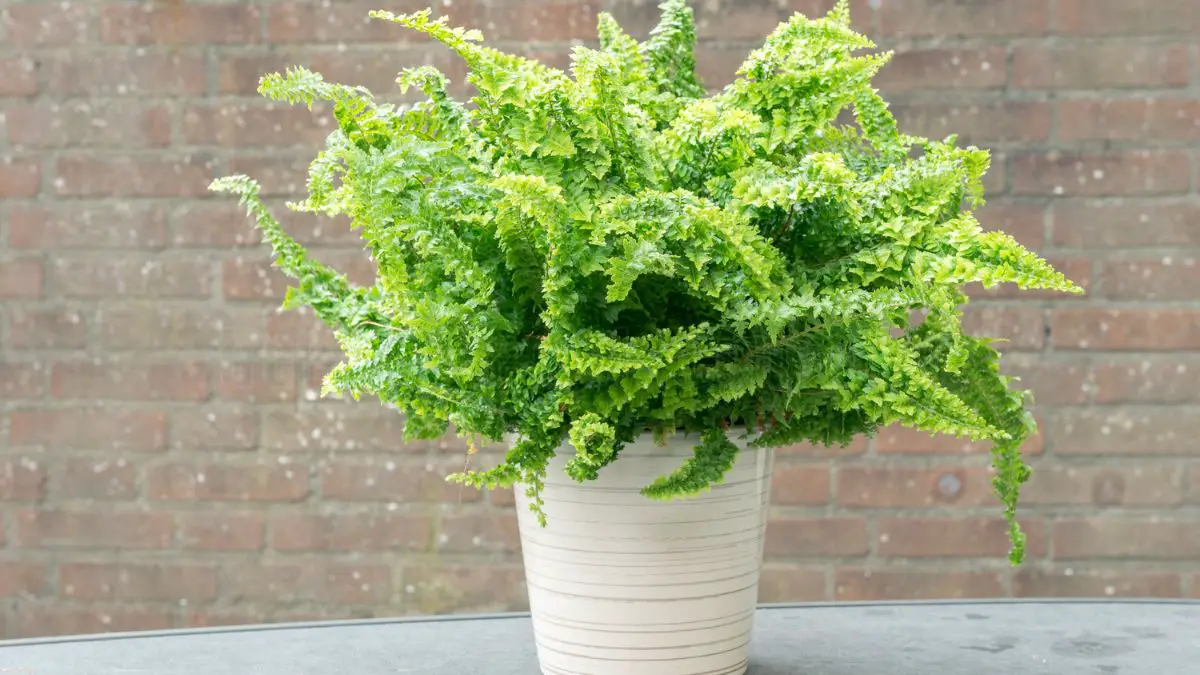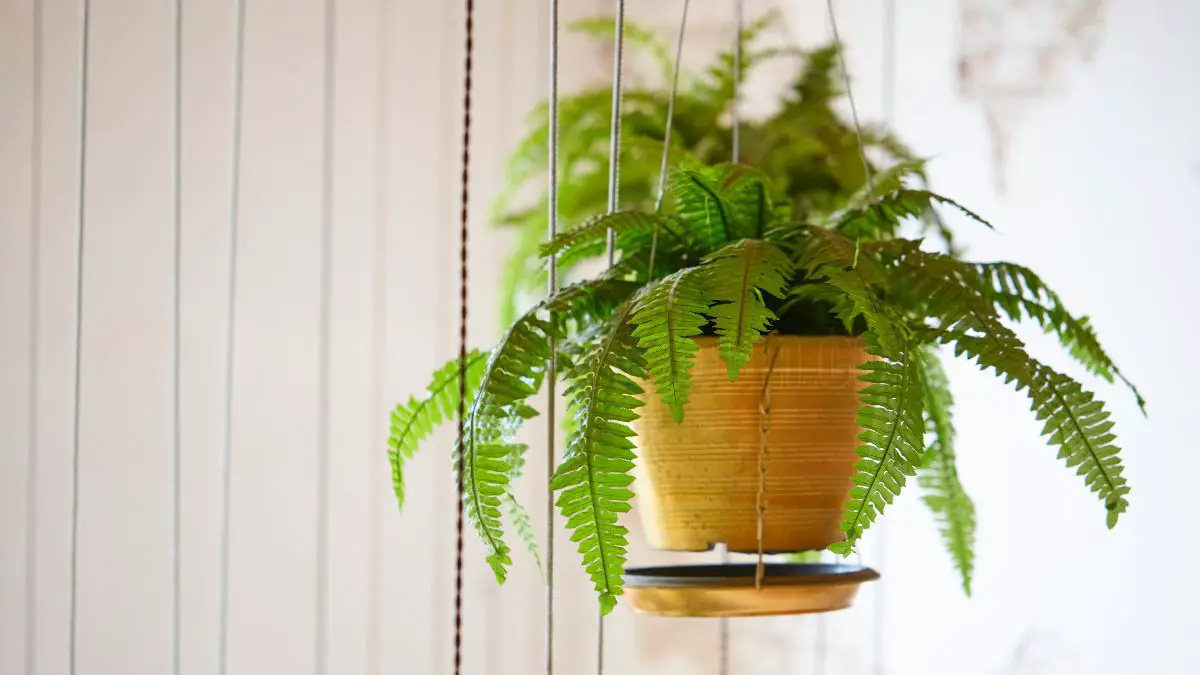Key Takeaways
- Give your houseplant Boston fern bright, indirect sunlight to keep them growing lush and green. Don’t keep it in direct sunlight though, as this will scorch the leaves. Turning your plant every so often will ensure it has an equal distribution of light.
- Keeping water needs in mind Water your Boston fern regularly, keeping the soil reliably moist but not waterlogged. Water only when the soil is dry to the touch and do not allow your fern to sit in any excess water.
- Keep humidity levels at least 50% by misting the fronds each day, or running a humidifier near your fern during dryer months. Placing your fern among a collection of plants can be another way to ensure a more humid climate.
- Maintain a temperature between 60°F and 75°F, avoiding cold drafts and heating vents to not stress the plant. Be proactive by checking for shifts in temperature to ensure your boston fern has a consistent home.
- Choose a potting mix that drains well and has plenty of organic material to promote strong root development. Repotting your fern every 2-3 years ensures that the fern has fresh soil and nutrients.
- Monitor your fern’s health closely, looking out for signs of distress such as leaf yellowing or frond curling. Tweak your care routine to set it up for success!
Boston fern care is all about recreating its natural habitat and keeping this big, beautiful houseplant healthy and happy. Native to tropical environments, Boston ferns flourish in high humidity and should be kept out of direct sun.
To ensure these ferns thrive, make sure to provide consistent moisture to the soil without over saturating. Routine misting will not only recreate the humid environment they thrive in, but it will prevent unsightly browning fronds.
Applying a balanced fertilizer every couple of weeks during the growing season will encourage full, bushy growth. By knowing these simple requirements, you can ensure that your Boston fern remains beautiful.
It’s an easy way to add a lot of green to your space. Coming up next, our ultimate guide to keeping your Boston fern happy, healthy and thriving!
Boston Fern Care Guidelines

Caring for Boston ferns indoors involves paying attention to their unique needs, particularly regarding light, water, humidity, temperature, soil, and seasonal adjustments. Get to know these basics to ensure a healthy and beautiful Boston fern plant. Follow these care guidelines to keep your potted Boston fern lush and vibrant!
1. Understand Light Requirements
Boston ferns thrive in bright, indirect light. This will require you to put them by windows where they will be able to soak up the light minus getting burned from direct sunbeams. Exposure to direct sunlight can cause burning and wilting of fronds, severely impacting the plant’s health.
An ideal location might be a window facing north or east, where sunlight is gentler. To encourage uniform growth, turn the plant every few weeks. This technique helps promote light to all angles, creating a denser look.
If light conditions look a bit too direct, you can erect some sheer drapes to filter that sun and give your fern a more dappled setting. Monitoring leaf color is another way to tell. Deep vibrant green fronds means you’ve got the right amount of light, but pale or brown tips means your fern is getting too much sun.
2. Optimize Watering Routines
When it comes to Boston fern care, watering is one of the most important tasks. Soil should be kept consistently damp, but never wet, so you’ll want to find a watering routine that works for you. Always check soil moisture before watering.
Once you put your finger in the dirt and the top inch feels dry, it’s time to water. Ensure the water penetrates deep into the soil. This should enable it to drain completely from the bottom of the pot. This deep watering method helps establish a robust root system.
As seasons change, your watering schedule will need to change. In hotter months especially, plants outside may need to be watered every day or every other day. At the same time, indoor ferns generally love a good weekly watering.
Just be sure to avoid letting the plant stand in water! This practice can lead to overwatering and root rot, which is detrimental to your fern’s well-being.
3. Maintain Ideal Humidity Levels
Humidity is probably the most important aspect of Boston fern care. Boston ferns prefer environments with 60% to 80% humidity. If you live in a drier climate, or your home is dry — as many are in the winter — a humidifier can assist in keeping humidity levels ideal.
Instead, a DIY pebble tray with water under the pot will increase humidity as the water evaporates. Frequent misting of the fronds will further recreate the steamy environment these plants crave.
Keeping your Boston ferns alongside other houseplants will help foster a humid micro-environment that will please all of your flourishing fronds. If low humidity continues to be a problem, invest in an in-home humidifier. This simple tip can go a long way in ensuring your ferns are healthy and happy!
4. Control Temperature Fluctuations
Temperature stability is very important for Boston ferns. They thrive in temperatures around 65°F to 75°F. They can survive in temperatures down to 40°F-50°F, but keeping them in that cold of an environment for too long will put a strain on the plant.
Make sure they’re protected from drafts, heaters, and air conditioning vents, which lead to quick temperature fluctuations. Keeping track of the temperature with a thermometer will allow you to keep them in the most ideal environment.
Being watchful for these changes is especially critical during winter months when the temperatures indoors can vary widely. Avoiding extreme fluctuations in temperature, whether hot or cold, will go a long way toward ensuring your fern lives a long life.
5. Choose the Right Soil Composition
Selecting the right soil mixture is essential to your Boston fern care. A loose, well-draining potting medium is very important for healthy root development. Organic amendments such as peat moss or coconut coir will improve moisture retention without compaction.
This keeps humidity levels high, but heavy soils can lead to root rot as water will get trapped, so steer clear of them. Repotting your Boston fern every two or three years is another good practice, as it refreshes the soil and adds more nutrients.
The best time of year to do this is spring when your fern is most actively growing. A new potting soil will give it a nutrient infusion and jumpstart growth.
6. Identify Stress Indicators
Noticing stress indicators in Boston ferns means you can help them sooner. For example, yellowing leaves can mean either overwatering or a nutrient deficiency. Curled fronds can be a sign of underwatering or low humidity.
Leaf drop is another cue that something’s gone wrong, whether due to environmental stress, pests, or sudden shifts in care. Taking time to observe for yellowing leaves or unexpected growth will allow you to address problems before they become extreme.
By treating these symptoms as soon as you notice them, you can bring your fern back to good health to enjoy all its lush, green beauty again.
7. Seasonal Care Adjustments
Seasonal shifts call for changes in care practices. In the hot summer months, Boston ferns require more frequent watering and monthly feeding as well. Aim to fertilize every six months during these months to promote healthy, lush growth.
When the seasons change, cut back on fertilization during their dormant months to prevent nutrient accumulation. This will be especially important during winter months, when indoor air is drier, as a result of heat being used regularly.
Keep an eye on the light level in the fall and winter, because shorter days may affect growth.
Types of Indoor Ferns
Indoor ferns, such as the beautiful Boston fern plant, are a wonderful way to bring in a lush aesthetic and a gorgeous piece of nature to your home. Learning the distinct qualities of each type will prepare you to choose the right fern species for your environment.
1. Explore Popular Indoor Fern Varieties
Boston ferns (Nephrolepis exaltata) are perhaps the most famous indoor fern, famous for their feathery, arching fronds. You’ve got the Kimberly Queen, a fern that doesn’t flop over, and the Fluffy Ruffles, known for their delightful curly leaves. Each of these varieties appeals to a unique taste among fern lovers.
Boston ferns do best in temperatures between 60°F and 75°F and enjoy very humid conditions. These ferns can usually be found at your local nursery or online, which means they are pretty easy to get.
2. Compare Unique Characteristics
When listing different types of ferns, a side-by-side comparison table can effectively show their unique frond shapes and colors together. For example, hardy Boston ferns exhibit long, airy fronds, while Kimberly Queen shows off a more robust form. Each type is different in their growing habits.
Some are more contained, while others, such as the Boston fern, can be more sprawling. Care needs vary. Though humidity is loved by all ferns, Boston ferns flourish in levels over 80%, perfect for indoor settings.
3. Assess Care Requirements for Each Type
Providing proper care for these ferns means being mindful of their light, watering, and humidity needs. Boston ferns require frequent misting or a pebble tray filled with water to keep their humidity levels up.
Very specific temperature preferences, including cooler nights, are crucial. Basic upkeep, such as regular watering and seasonal fertilizing, will keep your plant thriving.
Pruning and Repotting Techniques
Regular pruning and repotting are essential tips for maintaining your Boston fern plant, ensuring it thrives indoors and enhances the overall beauty of your home or office.
1. Best Practices for Pruning
Proper pruning is essential for maintaining a healthy fern. Here’s how to do it:
- Gather tools: sharp scissors or pruning shears, and gloves.
- Cut off any brown or dead fronds to promote new growth.
- Never prune more than one-third of the crown at a time to reduce stress on the tree.
- When to prune: Pruning in the active season—generally spring and summer—is usually best.
Being aggressive in pruning will keep a bushy shape and avoid the leggy growth often seen in Boston ferns.
2. When to Repot Your Ferns
Knowing when to repot is half the battle. Signs include root crowding at which point roots start coming out through the drainage holes.
How often to repot your ferns: Repot every 2-3 years in the spring, when the plant is actively growing. Select a new container that is 1-2 inches in diameter wider than the previous one so the plant has room to grow.
Make sure the new pot has plenty of drainage holes so the potting medium doesn’t stay too soggy. To take out the fern, lightly knock the sides of the pot to loosen the soil and roots.
Be sure to add new potting soil at the bottom of the new pot before adding in your fern. After repotting, avoid direct sun and provide high humidity for a few days to help it recover from the shock.
3. Enhancing Aesthetic Appeal
Utilizing ornamental pots or planters can take your Boston fern’s aesthetic beauty to the next level. To create a beautiful indoor jungle, keep ferns grouped with compatible houseplants.
Play with varying heights and groupings, or try hanging baskets for an unexpected presentation.
Fertilization and Growth Impact
Fertilization is key when caring for Boston ferns indoors, leading to robust growth and lush foliage. If you want truly stunning and healthy potted Boston ferns, learning how, when, and why to fertilize will make all the difference, especially in the hot, humid climate of Marrakech.
1. Understand Fertilization Routines
- Apply a balanced liquid NPK fertilizer through the growing season.
- Dilute fertilizers to prevent root burn.
- Observe plant response and adjust frequency accordingly.
Liquid NPK fertilizer applications should be made every four to six weeks, starting in the spring, for best results. Diluting the fertilizer makes sure it’s giving the nutrients without risking damage to the sensitive roots of the Boston fern.
By observing how the plant responds, you can begin to dial in your fertilization practices.
2. Impact on Foliage Density
Appropriate fertilization improves the density and overall health of Boston fern fronds. When foliage vigor is increased due to more available nutrients, foliage becomes thick and dense.
This is why balanced fertilization is so important. Too much of one nutrient can stop growth in its tracks. Tracking foliage density is a simple measure to gauge effective maintenance.
3. Organic Fertilization Options
Try organic fertilization options such as compost tea or worm castings. These organic fertilization solutions keep your plants healthy and help you support sustainable gardening practices.
Organic fertilizers not only enhance soil health, but strengthen plant resilience against pests and diseases. Creating homemade organic fertilizers can be both a cost-effective and enriching experience for gardeners.
Pest Management Strategies
Caring for Boston ferns means being on watch for insect pests that can endanger their health and beauty. Common pests include aphids, spider mites, and mealybugs, which can lead to wilting, discoloration, and overall decline in plant health.
Pest detection and surveillance are critical for successful control. Early pest detection is essential. By acting quickly, you can prevent small problems from becoming larger ones.
1. Identify Early Signs of Infestation
Recognizing the early signs of an infestation in your indoor plants, like the beautiful Boston fern, allows you to address the issue before it becomes a major problem.
- Sticky residue on leaves, often indicating sap-sucking pests.
- Fine webbing, a common sign of spider mites.
- Visible insects on fronds, signaling a more significant problem.
- Physical damage, such as changes in leaf color or texture, including yellowing, browning, or curling.
- Routine checks of the undersides of leaves, where many pests like to lurk.
2. Organic Treatment Methods
In the fight against pests, organic treatments like insecticidal soap and neem oil are both powerful and safe. For minor infestations, hand-pulling helps save your plants.
Creating habitats for beneficial insects or introducing them, such as ladybugs, can help keep pest populations in check naturally. The key here is to be precise in your treatments and avoid any application that would adversely affect the fern.
3. Preventative Measures
To prevent pest infestation, keep humidity and air flow high, which is especially important for the well-being of ferns. By regularly cleaning the undersides of the leaves, you eliminate the dust that pests love to hide in.
Quarantine new plants for two weeks before introducing them into your collection. This very easy step goes a long way in keeping these unwelcome spreaders of disease at bay.
Common Myths About Boston Ferns
Boston ferns, prized for their feathery leaves, are popular houseplants surrounded by a fog of myths. Setting the record straight on these common misconceptions is important for anyone who wants to care for these beautiful Boston ferns with ease.
1. Debunking Misconceptions
- Myth: Boston ferns need constant direct sunlight.
Truth: They actually prefer indirect light. Bright, filtered light helps them thrive while preventing the leaf burn that direct sunlight can inflict.
- Myth: Growing Boston ferns indoors is too difficult.
Truth: With proper humidity and care, they adapt well to indoor environments. Consistent misting and providing them a location out of strong air movement can help create the microclimate they desire.
- Myth: Boston ferns are high-maintenance plants.
Truth: While they do require attention, understanding their needs like watering when the top inch of soil is dry makes growth manageable.
2. Research Insights on Care Practices
Research has consistently shown that humidity is paramount for Boston ferns. Keeping humidity levels at 50-70% is proven to increase their growth.
Additionally, research emphasizes that implementing a pebble tray or humidifier is an excellent way to duplicate the humid home they love.
Research indicates that pest control with natural solutions—for instance, neem oil—works better than synthetic chemicals. Plus, these methods are better for the environment than chemical options.
Fertilizing with a balanced, water-soluble fertilizer applied regularly during the growing season encourages steady growth and a vibrant fern.
Conclusion
Proper care of your Boston fern will reward you with greenery and life in your home. By knowing what it requires, you’ll find it simpler to prevent this verdant houseplant from withering away. Water with lukewarm water to keep the soil slightly damp, place in bright indirect light, and give high humidity. Prune strategically to promote new growth, and don’t be afraid to repot when necessary.
Keep prevention in mind, keep an eye out for pests, and shatter those pest control myths that can steer you wrong. Every fern is different, so spend time getting to know yours and figure out what suits them best.
With some time and care, your Boston fern will thrive. Take a step into the wonderful world of fern care and show off that green thumb!
Frequently Asked Questions
What is the best light for Boston ferns?
What is the best light for Boston ferns indoors? Avoid placing the Boston fern plant in intense sunlight, as that will burn the delicate fronds. An area by a window where the plant receives indirect light works best.
How often should I water my Boston fern?
Water Boston ferns when the top 1 inch (2.5 cm) of soil is dry, typically once a week. However, you can adjust this based on your home’s humidity and temperature for optimal Boston fern plant care.
What type of soil is best for Boston ferns?
Provide your beautiful Boston fern plant with a well-draining potting mix that’s high in organic matter. A balanced combination of peat moss, perlite, and compost will help ensure your roots stay happy and healthy.
Do Boston ferns need humidity?
Do Boston ferns indoors need humidity? To maintain the health of your beautiful Boston fern, keep humidity levels at 50% or above by regularly misting the leaves or using a humidity tray near your potted Boston fern.
When should I fertilize my Boston fern?
Plan to fertilize your indoor plants, including the beautiful Boston fern, every 4-6 weeks from spring to early fall. To encourage lush growth, feed them with a diluted, balanced liquid fertilizer during spring and summer months.
How do I prune my Boston fern?
To ensure your beautiful Boston fern plant thrives, keep dead or yellowing fronds pruned regularly, allowing new growth to flourish while using clean, sharp scissors or pruning shears.
What pests affect Boston ferns?
Spider mites and mealybugs can be common pests on Boston ferns indoors. Keep an eye on your beautiful Boston fern, and if you notice any infestations, use insecticidal soap or neem oil to eliminate them.
Image Source: Paid image from CANVA




